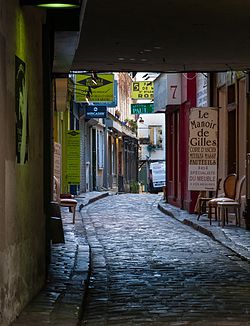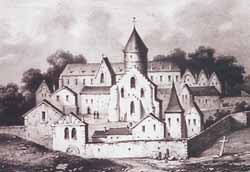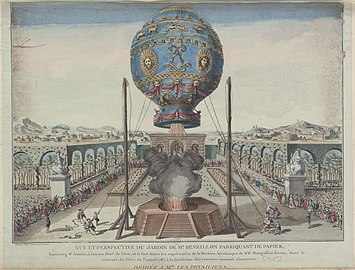History
Early years
The suburb was the location of the Battle of the Faubourg St Antoine on 2 July 1652.
In the 17th century, according to Piganiol de La Force, "The Faubourg Saint-Antoine increased prodigiously from the large number of houses that were built there, both because of the good air and because of the king's letters patent of 1657, which exempted from the qualification of mastership all artisans and tradespeople who lived there." Firewood and construction timber from higher up the Seine was unloaded at the nearby Quai de la Rapée on the Île Louviers and stored in the faubourg, leading to development of woodworking crafts.
Skilled Flemish and German artisans, often Protestant, moved to the faubourg and worked as carvers, gilders, polishers, turners and cabinetmakers. Jean-Baptiste Colbert established the royal mirror factory on the rue de Reuilly. The factory of Jean-Baptiste Réveillon on the rue de Montreuil on part of the site of the former Folie Titon became the royal wallpaper factory under Louis XVI of France. In April 1789 the contractor running the Réveillon factory sparked a riot by threatening to cut wages. The factory was badly damaged, troops were brought in and several dozen people were killed.
19th century
In 1808 there were 750 workers, mostly children, in the rue de Charonne spinning mills of François Richard-Lenoir (1765–1839) and Joseph Lenoir-Dufresne (1768–1806), housed in a former convent. The machines were horse-powered. In the uprising of June 1848 the Faubourg Saint-Antoine was the last to capitulate, after being heavily shelled by artillery from the Bastille area and then attacked by troops from the Popincourt quarter, with many casualties, in the morning of June 26, 1848.
The Faubourg Saint-Antoine, controlled by the Reuilly barracks, was densely populated with people of the working and "dangerous" classes. Baron Georges-Eugène Haussmann wanted to ensure that an insurrection could easily be suppressed. He proposed to Napoleon III to lower the level of the Canal Saint-Martin and cover it so it could be crossed by the Boulevard de la Reine-Hortense (now the Boulevard Richard-Lenoir). He said, "I have rarely seen my august sovereign enthusiastic. This time he was so without reserve, so great an importance did he place ... on the work by means of which I proposed to remove the permanent obstacle ... to the line of control from which one could, in case of need, take the Faubourg Saint-Antoine from the rear."
Haussmann split the faubourg between the 11th and 12th arrondissements and replaced the street names with numbers, but the inhabitants continued to use the old names. The former faubourg retained its revolutionary character after it had been formally dissolved. According to Daniel Halévy,
As long as the Dreyfus crisis lasted the Fauberg Saint-Antoine was our fortress ... in the little room on Rue Paul-Bert, where we huddled together, workers and bourgeois, where we squeezed our chairs one against the other ... One day in autumn 1899, we watched for hours the return of the crown of workers who had been parading on the Place du Trône, before the Triomphe de la République, Dalou's bronze statue that had been unveiled that day. I doubt that 1848, with its famous festivals, or 1790, on the day of the Federations, saw a greater movement of the masses, or one so powerfully possessed by the spirit of the Revolution".

The Bastille was a fortress in Paris, known formally as the Bastille Saint-Antoine. It played an important role in the internal conflicts of France and for most of its history was used as a state prison by the kings of France. It was stormed by a crowd on 14 July 1789, in the French Revolution, becoming an important symbol for the French Republican movement. It was later demolished and replaced by the Place de la Bastille.
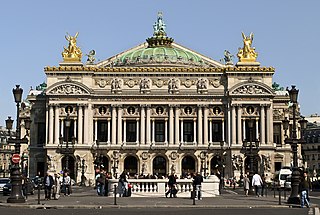
The 9th arrondissement of Paris is one of the 20 arrondissements of the capital city of France. In spoken French, it is referred to as le neuvième.
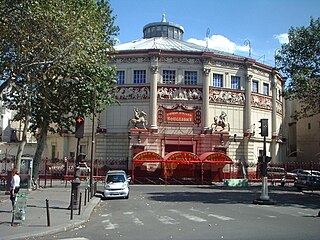
The 11th arrondissement of Paris is one of the 20 arrondissements of the capital city of France. In spoken French, this arrondissement is referred to as onzième.
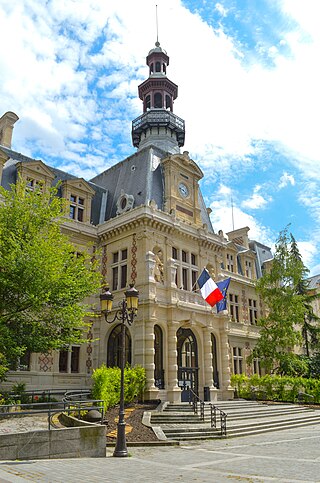
The 12th arrondissement of Paris is one of the 20 arrondissements of the capital city of France. Situated on the right bank of the River Seine, it is the easternmost arrondissement of Paris, as well as the largest by area. In 2019, it had a population of 139,297.

Bastille is a station on Line 1, Line 5 and Line 8 of the Paris Métro. Located under the Place de la Bastille and near the former location of the Bastille, it is situated on the border of the 4th, 11th and 12th arrondissement.
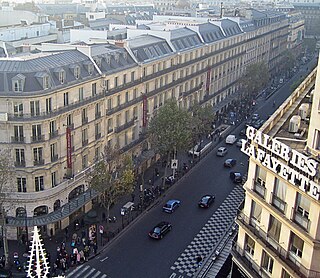
Boulevard Haussmann, 2.53 kilometres (1.57 mi) long from the 8th to the 9th arrondissement, is one of the wide tree-lined boulevards created in Paris by Napoleon III, under the direction of his Prefect of the Seine, Baron Haussmann.
The Réveillon riots between 26 and 29 April 1789 centered in the St. Antoine district of Paris where a factory which produced luxury wallpaper was owned by Jean-Baptiste Réveillon. The factory employed around 300 people. The riots were one of the first instances of violence during the French Revolution. The factory where the riot took place was unusual in pre-revolutionary France as the factory was guild-free in an era where guilds controlled quality standards.
Jean-Antoine-Gabriel Davioud was a French architect. He worked closely with Baron Haussmann on the transformation of Paris under Napoleon III during the Second Empire. Davioud is remembered for his contributions to architecture, parks and urban amenities. These contributions now form an integral part of the style of Haussmann's Paris.

Haussmann's renovation of Paris was a vast public works programme commissioned by French Emperor Napoleon III and directed by his prefect of the Seine, Georges-Eugène Haussmann, between 1853 and 1870. It included the demolition of medieval neighbourhoods that were deemed overcrowded and unhealthy by officials at the time; the building of wide avenues; new parks and squares; the annexation of the suburbs surrounding Paris; and the construction of new sewers, fountains and aqueducts. Haussmann's work was met with fierce opposition, and he was finally dismissed by Napoleon III in 1870; but work on his projects continued until 1927. The street plan and distinctive appearance of the centre of Paris today are largely the result of Haussmann's renovation.

Faidherbe–Chaligny is a station of the Paris Métro, named after the streets of Rue Faidherbe and Rue Chaligny.
Jean-Baptiste Réveillon (1725–1811) was a French wallpaper manufacturer. In 1789 Réveillon made a statement on the price of bread that was misinterpreted by the Parisian populace as advocating lower wages. He fled France after his home and his wallpaper factory were attacked and set on fire in what came to be known as the Reveillon riot. In 1791 he leased his business premises to the wallpaper manufacturer Jacquemart & Bérnard.

Faubourg Saint-Germain is a historic district of Paris, France. The Faubourg has long been known as the favourite home of the French high nobility and hosts many aristocratic hôtels particuliers. It is currently part of the 7th arrondissement of Paris.

Jean Beausire was an architect, engineer and fountain-maker and the chief of public works in Paris for King Louis XIV of France and King Louis XV of France between 1684 and 1740, and was the architect of all the public fountains constructed in Paris that period. Several of his fountains still exist and continue to work. Three streets in the 4th arrondissement of Paris today carry his name: Rue Jean-Beausire, Impasse Jean-Beausire, and Passage Jean-Beausire.
This article presents the main landmarks in the city of Paris within administrative limits, divided by its 20 arrondissements. Landmarks located in the suburbs of Paris, outside of its administrative limits, while within the metropolitan area are not included in this article.

Boulevard Voltaire is a well-known boulevard in the 11th arrondissement of Paris. It was created by Baron Georges-Eugène Haussmann during the reign of French emperor Napoleon III. Originally named Boulevard du Prince-Eugène, it was renamed Boulevard Voltaire on 25 October 1870 in honour of the French Enlightenment writer, historian, and philosopher Voltaire.
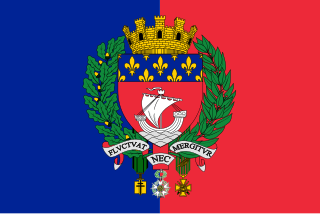
The following outline is provided as an overview of and topical guide to Paris:
This page is based on this
Wikipedia article Text is available under the
CC BY-SA 4.0 license; additional terms may apply.
Images, videos and audio are available under their respective licenses.
